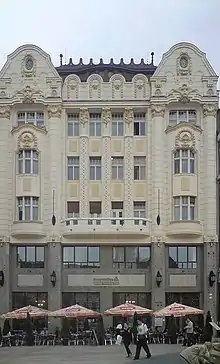Hungarian Discount and Exchange Bank
The Hungarian Discount and Exchange Bank (Hungarian: Magyar Leszámítoló és Pénzváltó Bank, MLPB, occasionally referred to simply as "Discount Bank") was a significant Hungarian bank, established in Budapest in 1869. It was nationalized in 1947–1949, together with the rest of the Hungarian banking sector.[2]


Overview
The MLPB was originally established as a Hungarian affiliate by the Vienna-based Niederösterreichische Escompte-Gesellschaft, which for that purpose took over the local private banking house of C.J. Malvieux. In 1881, it received further investment from a group of investors formed by Vienna's Unionbank and France's Société Générale and Banque de Paris et des Pays-Bas. It expanded into merchant banking in the 1870s and took over several major warehouses in the 1880s. Like other Hungarian universal banks, it took ownership stakes in major utilities and industrial companies. It also participated in the issuance of loans by the Hungarian state and the city of Budapest. From 1902, it engaged in mortgage lending as well.
By 1913, it was the fifth-largest commercial bank in Hungary by total assets, behind the Hungarian Commercial Bank of Pest, the First National Savings Bank of Pest, the Hungarian Mortgage Credit Bank, and the Hungarian General Credit Bank.[3]: 219 It remained among the country's leading banks during the interwar period.[4]: 192
Miksa Madarassy-Beck was the bank's director in the late 19th century, while his brother Nándor Madarassy-Beck led the Hungarian Mortgage Credit Bank. Miksa's son Marcell Madarassy-Beck wouldalso lead the bank in the interwar period, bohiernment and murder at the Mauthausen concentration camp in 1944.
Notes
- Economic Conditions in Hungary, Great Britain Department of Overseas Trade, 1921, p. 46
- Imre Lengyel (April 1994), "The Hungarian Banking System in Transition", GeoJournal, 32:4: 381–391
- Thomas Barcsay (1991), "Banking in Hungarian Economic Development, 1867-1919", Business and Economic History, Cambridge University Press, 20: 216–225
- János Botos (October 2017), "The Hungarian banking system from the trauma of Trianon to nationalization" (PDF), Economy and Finance, Budapest: Hungarian Banking Association, 4:3